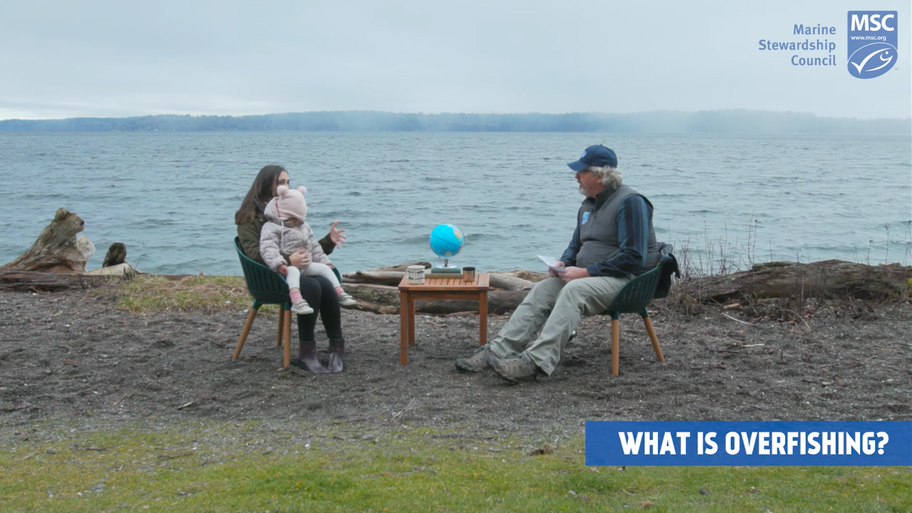When you make the decision to buy certified sustainable seafood, you become part of a global movement to support sustainable fishing practices and ensure healthy and delicious seafood will be available for generations to come.
 Still of Dan Averill, Senior Fisheries Manager, from Conver-sea-tions video series
Still of Dan Averill, Senior Fisheries Manager, from Conver-sea-tions video series
What is Overfishing?
Overfishing occurs when more fish are taken out of the ocean than can
naturally be replenished. Think of it as a bank account. If you take out more money than you deposit, eventually you'll empty the account.
This happened with the
West Coast Groundfish Fishery back in the 1990s. What is now a successful, sustainable fishery was once on the brink of disaster. Intense fishing pressure, combined with management challenges and unfavorable environmental conditions, caused this once abundant fishery to collapse.
It was declared a federal disaster in 2000 by the National Oceanic and Atmospheric Administration (NOAA), and everyone involved in the fishery, from the fishermen to the processors, was left hurting and unsure of what the future would hold for
both their community and the fish stock.
What is Sustainable Fishing?
Sustainable fishing occurs when people fish from a population with enough fish to start and leave enough behind to keep the population healthy. It also leaves no lasting negative impact on the marine environment or other ocean life
and is managed by a responsible organization that can adapt to ever-changing conditions.
Instead of abandoning the fishery and moving on to more abundant species or ceasing to fish altogether, the groundfish fishermen were committed to help the fishery recover and manage it sustainably going forward.
To make the West Coast Groundfish Fishery sustainable, fishermen reduced the size of the fleet and worked in partnership with environmental nonprofit organizations and fishery managers to fundamentally change the way the fishery operated. Better technology, on-board observers, off-limits fishing areas, and other fishery management tools helped the groundfish population recover.
With the hard work of fishermen, fishery managers, and scientists, the fishery reached a new milestone just fourteen years after hitting rock bottom.
In 2014, they achieved MSC certification—and to this day the fishery remains more abundant (and sustainable!) than ever.
Back to our original bank analogy: you can’t take more money than you have; you can’t take money from someone else’s account; there’s always someone overseeing all the transactions to ensure everything is accurately reported.
Sustainable fishing is essentially a healthy, well-functioning system that benefits both the borrower and the bank (or, in this case, the fisherman and the fish)!
Should I Be Worried About Overfishing?
However, the solution to our overfishing problem is not to stop fishing or eating fish altogether—that is an unrealistic solution that would actively harm the billions of people globally tied to the seafood industry.
The livelihoods of 1 in 10 people depend on fishing and aquaculture. Some coastal communities depend directly on nutrient-rich fish for food security, and many more rely on the income to sustain their families.
The Parties to the Nauru Agreement (PNA) tuna fishery on the Marshall Islands is a community that has managed to strike the balance between protecting and utilizing the large tuna stocks that live in their waters, but not without its share of obstacles.
Facing overexploitation by illegal and unsustainable fishing by foreign vessels, the PNA countries decided to take back control of their fishery—on their own terms. By moving away from "renting their resources" to taking ownership and implementing
sustainable fishing practices across their processes, they have been able to successfully protect the quarter of the world's tuna stocks that lives in their waters while
also keeping their livelihood.
When overfishing goes unchecked, these communities risk losing access to a high-quality protein source. However, if we all collectively decide to stop eating seafood, we will negatively impact these communities and their livelihoods.
So, what do you do?
How Do We End Overfishing?
Luckily for seafood eaters, wild-caught fish can be an environmentally friendly and renewable resource—as long as we leave enough fish to continue to reproduce and rebuild populations.
At the MSC, we believe the answer to overfishing is for all seafood eaters to make the switch to sustainable seafood. Purchasing certified sustainable seafood is an easy way to ensure you're not contributing to overfishing, and that you are
supporting sustainable fishing communities around the world.
Every time you chose sustainable seafood, you are signaling to your retailer that this is important, which leads them to source more sustainable products, which eventually leads to other fisheries seeing this success and taking the next step in their sustainability journey.
It’s a virtuous cycle
!
The more people that make the switch to certified sustainable seafood, the more likely we are to have seafood available for generations to come.
 Still of Dan Averill, Senior Fisheries Manager, from Conver-sea-tions video series
Still of Dan Averill, Senior Fisheries Manager, from Conver-sea-tions video series